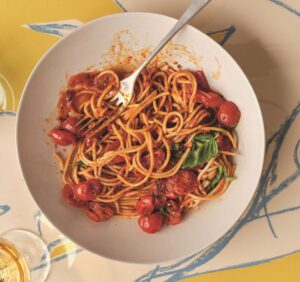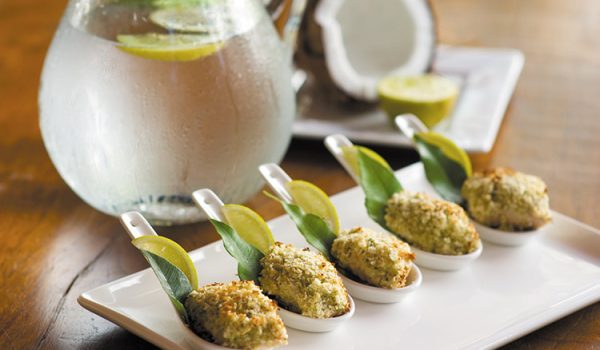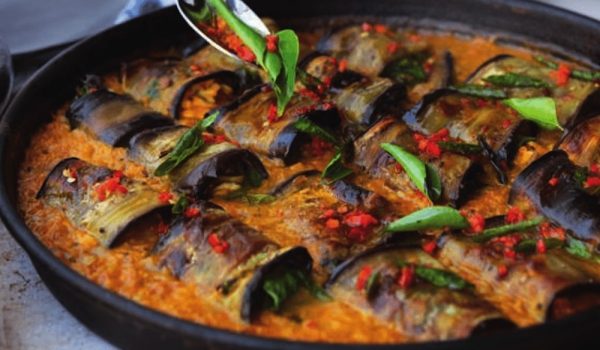Matt Preston’s delicious Spaghetti Bolognese recipe is an easy dish to make for the family. Spaghetti bolognese is an Italian dish from the city of Bologna. Here he shares the history of the meal made famous by the Italians and his own special recipe.
Myth
There are a few recipes in this book that I’ve struggled to improve, and this is one of them. Sure, we’ve specced up the mince and have tried to find ways to shorten the cooking process without impacting on the richness of the dish, but it remains very similar to the bolognese that has been one of my most popular recipes since it appeared in my first cookbook ten years ago. I have also not changed my views on bolognese’s origin. While the dish has roots in Italy, it was Italian migrants living in the UK, Australia or the US who created the dish as we know it – a combination of tomatoes, mince and spaghetti.
The gastronomic city of Bologna is famed for its tortellini, mortadella, gelati and zuppa inglese; a city so associated with rich food and good living that its nickname is ‘Bologna la grassa’, or ‘Bologna the fat’! However, the dish of spaghetti bolognese is largely unknown there. Sure, they serve meat sauce or ‘ragù Bolognese’ over wide pasta (ideally a rich, fresh egg tagliatelle, but it can also be fettuccine or pappardelle), but these sauces are made with little, if any, tomato at all.

The first recipes for ragùs to serve on pasta appear in Italy at the end of the eighteenth century. While there had been standalone stews in Italy before, the ragout was a sexy new French idea. It didn’t arrive with Napoleon’s invading troops in 1796, as is commonly thought, but was adopted by the royal court in Naples. Vincenzo Corrado, a cook at the court, includes recipes both for ragù as well as a tomato sauce for spaghetti in his Il cuoco galante (‘The gallant cook’, 1773), but Alberto Alvisi’s was the first to put a ragù with pasta in his recipe for ragù per i maccheroni. Alvisi was the cook to the Cardinal of Imola, Gregorio Chiramonti from 1783 to 1799. Alvisi’s meat sauce was made with diced beef, pork or chicken giblets flavoured with lard, onions, cinnamon, black pepper and tomatoes. This is then baked with the pasta, or maccheroni.
After this point, ragùs to be served atop pasta became commonplace. There are versions from Bari and Sicily. In Naples and Abruzzo they made a tomato sauce with meatballs; and in Genoa they had il tocco, a rich ragù made from cooking a slab of beef for an age with tomatoes and onions. Niccolò Paganini, the great violist who also had a prodigious appetite, shared his recipe for this sauce with ravioli in a letter from 1839. Other than his choice of pasta and not mincing the beef, it’s pretty much a modern-day bolognese.
While these ragùs have some similarities to our bolognese, the first recipe actually to partner the name ‘bolognese’ with pasta wasn’t published until 1891.

Pellegrino Artusi’s groundbreaking Italian cookbook La scienza in cucina e l’arte di mangiar bene (‘Science in the Kitchen and the Art of Eating Well’, 1891) was an attempt to document the culinary unification of Italy, but his recipe for maccheroni alla Bolognese is very different from what we would call a bolognese. Artusi doesn’t use tomato, and his ragù was made with livers, cream and little cubes of beef. He even recommended adding truffles and mushrooms. The pasta used also wasn’t the flat tagliatelle or fettuccine that they demand in Bologna today but denti di cavallo (aka horse teeth!), a type of wide, ridged rigatoni.
So, with a tomato-free meat sauce from Bologna and endless instructions to use wide or thick pasta for this ragù, it’s clear that Italy was not on board with our spaghetti bolognese. It’s worth remembering a few things here. First, before World War II, 80 per cent
of Italians ate a plant-based diet, as meat was so expensive. Second, tomato-based sauces like Naples’ simple marinara were largely a southern Italian thing – the first recipe for a ‘red’ or vegetarian tomato sauce with pasta was published in 1770 by Francesco Leonardi. And finally, for many Italians, fresh pasta was a Sunday or feast day meal. Polenta, bread and rice were more common everyday staples.
These factors help underpin the theory that spaghetti bolognese was the creation of Italian migrants in the United States, United Kingdom and/or Australia. Meat was so much cheaper in these nations – food represented just 25 per cent of the weekly household budget, rather than 75 per cent back in the old country – and ingredients like tinned tomatoes, dried spaghetti and cheap cardboard tubes of parmesan were readily available in the early twentieth century. Add in the fact that so many of these migrants from around the turn of the nineteenth century came from Italy’s south, home of tomato sauce on vermicelli or spaghetti, and it almost seems inevitable that a meat-based tomato sauce for spaghetti would be created as an everyday meal.
Many point to Elizabeth David as the one who introduced the English-speaking world to ‘ragù Bolognese’ in her Italian Food (1954), but even a cursory study of papers in the British Newspaper Archive shows that bolognese was well established by then. It is there in a fulsome restaurant review in the Daily Herald (1936), and the earliest UK recipe I can find for something called spaghetti bolognese pops up in the Daily Mirror in 1938 (although it uses kidneys and tomato ketchup?!).
By 1939, cans of spaghetti bolognese were being sold for 9 pence a tin, showing the dish must have achieved some form of mainstream acceptance. The recipe came from Gennaro’s, a London restaurant that the Tasmanian Mercury reported in 1937 was a ‘favourite haunt for Australians with epicurean tastes’. Here in Australia, Cribb & Foote of Ipswich had been selling tinned spaghetti with tomato sauce and cheese since 1925.
Mentions of spag bol in the UK rise dramatically after World War II. However, in 1958, The People reported that Londoners were more adventurous eaters than other Brits because they were ‘eager to try exotic foreign things like spaghetti Bolognese and yoghourt’. There’s also a great story from 1949 about a UK hotel manager seeking to please twenty Italian tourists by serving spaghetti bolognese, only to find when he walked into the dining room that the Italians had refused to eat it as they didn’t know what it was. The English guests, on the other hand, had devoured it, confirming that spag bol was still unknown in Italy but already popular in the UK.

While we are getting all anecdotal, the shortening of spaghetti bolognese to ‘spag bol’ or ‘spag bog’ was, The Times of London opined, because people were nervous about pronouncing or spelling bolognese (or bolognaise, as it is known in the UK, where they adopted the French spelling).
The US history of bolognese is a little more sketchy. Over the almost 18 million digitised newspaper pages held by the Library of Congress, spag bol gets only a handful of mentions, compared to well over 120 hits for spaghetti and meatballs. It seems that spaghetti and meatballs was really the US’s spag bol.
And so to Australia. Put the words ‘spaghetti’ and ‘bolognese’ into the National Library of Australia’s newspaper archive, and you immediately hit gold.
There’s a recipe for tomato sauce with cheese on spaghetti in the Queensland Times in 1925, and in 1931, in the Italo-Australian, there’s talk of a department store, Mark Foy’s, selling spaghetti with ‘juicy’ bolognese sauce for Lent. This is the earliest mention of spag bol I can find anywhere – not just here in Australia. I’d also argue that the fact it is being used as a selling point in an advertisement implies readers were already happily familiar with the dish.
The tagliatelle bolognese on the menu at Romano’s in Sydney in 1938 had morphed into spaghetti bolognese by 1939 (Daily Telegraph). Through this we can see that spaghetti bolognese was firmly established as a dish in Australia by the late 1930s. Further evidence comes in May 1939, when Il Giornale Italiano reported on the opening of Luigi’s Spaghetti Bar in Kings Cross and mentioned chef Chinelli’s tagliatelle alla Bolognese; in a copy of the Sydney Morning Herald from July 1939, where we see four smartly dressed Sydney women seated around a chafing dish of spaghetti bolognese at the fashionable Prince’s; and, in the same year, the founder of Sydney menswear institution Lowes is pictured in the Daily Telegraph, dressed in white tie and tails, in the process of tossing spag bol for his guests. The only issue is that there is little written about what was in these early spag bols. We have to wait another ten years or so for that.
In 1952, spag bol was on the counter lunch menu at Mario’s (The Sun, Melbourne), and later that year it popped up as a recipe in the Australian’s Women’s Weekly, although the writers of the wonderful Australian Food History Timeline website point out that this was for a spag bol pasta bake topped with melted cheese. The sauce, however, is instantly recognisable as the one we know and love today. Even more telling, in an edition of Farmer and Settler (1953), writer Lucie Hamilton suggests a recipe presented for spaghetti bolognese is ‘still the best I’ve come across’, implying that’s there’s nothing new about spag bol in Oz. Pretty much all the recipes from around this time feature the familiar core of tomatoes, mince and spaghetti.
All these are recipes that appeared before Elizabeth David’s ragù Bolognese that is so often cited as the first mention of the dish in English.
Ironically, however, it is The Mail in Adelaide that published the first proper recipe for a spaghetti alla Bolognese that we’d recognise, on 13 May 1950. It came from Joy Campoli, the wife of acclaimed violinist Alfredo Campoli, who played with Dame Nellie Melba. In Joy’s recipe, minced steak and onions are fried and then slow cooked with tomato, water and tomato puree for four hours to make a sauce for spaghetti that she advises should never be overcooked. She learnt the recipe from her mother-in-law, the lauded Italian opera singer Elvira Celi, who had toured with Enrico Caruso and played to great acclaim from Buenos Aires to New York.
If I could cut this story right now, I’d suggest we have overwhelming evidence to claim spaghetti bolognese is a proudly Australian creation, but my ethics annoyingly insist that this would be a sin of omission. For, even though the earliest recipe for spaghetti bolognese appears in an Aussie paper, and so many of the earliest mentions of spag bol are Australian, it was at Elvira Celi’s urging that the Campolis moved to the UK from Rome in 1911, and not Adelaide. So, sadly but honestly, Joy Campoli’s recipe has to be credited as coming from Friern Barnet, north of London. We might have to share a little of the honour.

Matt Preston’s Delicious Spaghetti Bolognese Recipe
1⁄2 cup (125 ml) olive oil
100 g pancetta or bacon, finely chopped
2 carrots, peeled and finely chopped
2 large celery stalks, finely chopped
2 brown onions, finely chopped
1 tablespoon brown sugar
4 garlic cloves, crushed
1⁄4 cup (70 g) tomato paste (puree)
500 g pork mince
500 g pork and veal mince
500 g beef mince
2 cups (500 ml) red wine
2 × 400 g cans diced tomatoes
3 cups (750 ml) chicken stock
2 cups (500 ml) tomato passata
1 tablespoon Worcestershire sauce
6 cm piece of parmesan rind
4 cm piece of pith-free lemon peel
3 bay leaves
sea salt and freshly ground black pepper cooked spaghetti (or your choice of pasta),
to serve
grated parmesan, to serve
Heat 2 tablespoons of the oil in a large stock pot over medium-high heat. Add the pancetta or bacon, carrot, celery and onion, and cook, stirring, for 8 minutes until the vegetables are soft.
Add the sugar, garlic and tomato paste and cook, stirring, for 5 minutes or until the tomato paste starts to darken slightly. Transfer mixture to a large heatproof bowl.
Heat 1 tablespoon of the remaining oil in the pot. Cook the pork mince, breaking it up with a wooden spoon, for 5 minutes until lightly browned. Transfer to the bowl with the vegetables. Repeat in two more batches with the remaining oil and pork and veal mince and beef mince. Set aside.
Increase the heat to high. Add the wine to the pot and bring to the boil. Simmer for
5 minutes or until reduced by half. Deglaze the pot as you stir. Return the mince and veggie mixture to the pot. Add the tomato, stock, passata, Worcestershire, parmesan rind, lemon peel and bay leaves. Season well with salt and pepper.
Cover and bring to the boil, then reduce the heat to very low. Tilt the lid so the pot is partially covered, and cook, stirring occasionally, for 3 hours or until the sauce has reduced and thickened and is a glossy dark red colour. Serve with cooked pasta and grated parmesan.
TIPS
If we truly want to claim spaghetti Bolognese as an Australian dish we should start using kangaroo mince rather than pork or beef. Feel free to add extra finely chopped smoked streaky bacon if the mince is very lean. The addition of other indigenous ingredients however like lemon myrtle instead of lemon peel or a little ground wattleseed to add a back note of nutty, mild bitterness against all the salty, umami flavours may also be well worth experimenting with. If you do, let me know how you go by DMing me @mattscravat.
I should note that three hours might still seem like a long time for a ‘shortened’ recipe. In my defence, my original bolognese is a four-hour-plus cook!

For more information on Matt Preston’s new cooking book, visit here.
For more on Matt Preston on The Carousel, visit here.









